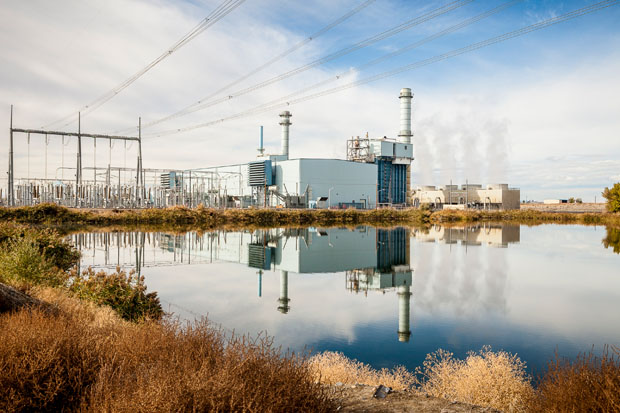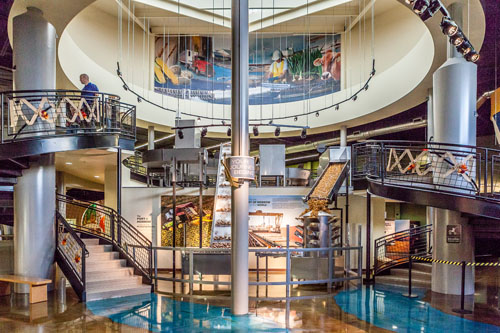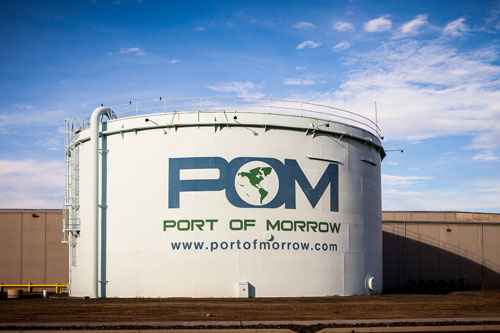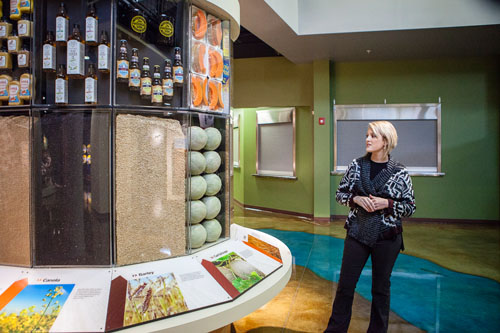BY JON SHADEL
Port of Morrow’s business-ready attitude has a surprising global impact.
Port of Morrow’s business-ready attitude has a surprising global impact.

Above: Coyote Springs Cogeneration Power Plant, a natural gas plant operated by Portland General Electric.
BY JON SHADEL
Labeled with the names of agricultural products, square buttons cover a display resembling a spaceship’s control panel. Above, a large TV screen hangs from the ceiling featuring an interactive map of the world. With a tap on a button labeled “potatoes,” the map highlights countries that receive the product from the Port of Morrow in the city of Boardman.
This exhibit appears in the Sustainable Agriculture and Energy (SAGE) Center, an interactive visitor center developed by the Port of Morrow to tell the story of the region’s industry, agriculture, energy production and transportation infrastructure. Exhibits like this help visitors visualize the region’s global economic impact.
The SAGE Center shows how the port sustainably develops the region’s industrial potential while supporting a great quality of life. All of this is possible due to a friendly business environment, international impact, advantages over larger metro areas and emphasis on community development.
Established in 1959, the Port of Morrow may be the youngest of Oregon’s 23 port authorities, but it contributes to the United States’ economic competitiveness by serving as the main port for freight distribution, export and value-added production of agricultural products. Strategically located along the Columbia River, the Port of Morrow is the second-largest port authority in Oregon (after the Port of Portland). And in a county of just under 12,000 residents, the 6,850 jobs created at the Port and the 57 Port-related businesses make it the primary driver of the region’s economy. Overall, the economic data indicates the Port and related business has an annual GDP of over $571 million and generate over $266 million in labor.
The port’s economic success results from maintaining an environment that is friendly to business. “We make it very easy to do business here,” says Lisa Mittelsdorf, director of economic development at the port. “One of the main ways we do this is by preparing industrial sites and making sure they are ready to go for developers.” Encompassing more than 8,000 acres, the port is the largest single owner of vacant industrial land in Oregon. And with three industrial parks and over 2,500 acres zoned industrial, the port is prepared for future development opportunities. “We want the world to know that the port is open for business,” Mittelsdorf says.

Due to excellent transportation links, the port truly has an international impact. “The world is our market,” adds Gary Neal, general manager of the Port. “Easy transportation links is one of the key advantages for industry,” he continues, explaining how various transit options conveniently link businesses to domestic and foreign markets: Barges, the most economical mode of transport, float cargo down the Columbia River to Portland and then to the open ocean. The Union Pacific Mainline passes through the Boardman Industrial Park, giving the port some of the best rail connections in the Northwest. And, of course, there are many nearby interstate freeways. “We’re truly at the crossroads,” says Neal.
 With advanced industrial infrastructure and excellent transportation links, the port provides the benefits of larger metro regions. But businesses at the port avoid many of the challenges found in urban locations. For one, costs of electricity are among the lowest in the country. And state-of-the-art utility operations provide economical access to clean water as well as efficient wastewater management systems. All of this makes clear why the port buzzes with industrial activity.
With advanced industrial infrastructure and excellent transportation links, the port provides the benefits of larger metro regions. But businesses at the port avoid many of the challenges found in urban locations. For one, costs of electricity are among the lowest in the country. And state-of-the-art utility operations provide economical access to clean water as well as efficient wastewater management systems. All of this makes clear why the port buzzes with industrial activity.
The impact the port has on the region’s livability can’t be easily portrayed in an exhibit for the SAGE Center, but the fact is just as important as it shows the benefits of responsible industrial development. This is most clear in the employment data: Despite the economic recession that stifled job growth throughout much of the state, the level of employment in Morrow County increased by 13.7% from 2006 to 2011 while overall employment in Oregon decreased by 4.9% in that same timeframe. Additionally, wages are also among the highest in the state outside of the Portland metro region.
 Other community benefits from the port are not as easily quantifiable. One example is the port’s participation in local and state government partnerships, providing flexible funds for local community development projects (such as housing assistance). And of course, educational facilities like the SAGE Center provide educational opportunities. A fee-free program allows schools to visit the center at no cost, ensuring the next generation understands the importance of the regional industrial activity.
Other community benefits from the port are not as easily quantifiable. One example is the port’s participation in local and state government partnerships, providing flexible funds for local community development projects (such as housing assistance). And of course, educational facilities like the SAGE Center provide educational opportunities. A fee-free program allows schools to visit the center at no cost, ensuring the next generation understands the importance of the regional industrial activity. 
“People who drive by us on I-84 can hardly imagine the importance of the economic activity that goes on here,” explains Kalie Davis, manager of the SAGE Center. “We’re not only an important port for Oregon,” she says. “We’re an important port for the world. And we hope this center helps more people understand the story of our region and its economic importance.”
Learn more at www.portofmorrow.com.




